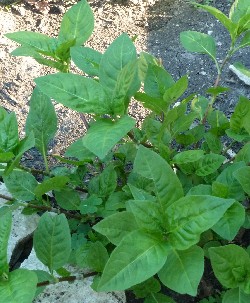On the
natural dye trail: a few days in Luang Prabang, Laos
By
Judith Musick
Like
many with interests in fiber arts, travel offers me
welcome opportunities to explore new textile traditions
and practices—to see and touch and learn about the work of
artists and artisans around the world. While traveling in
Southeast Asia this past February, I was fortunate to
spend some time in Laos, a country noted for its beautiful
woven textiles. It was particularly exciting to meet
people making and using natural dyes in and around the
city of Luang Prabang, a World Heritage site known for its
numerous Buddhist temples and monasteries. Especially
memorable were visits I made to an innovative weaving
company, and a “weaving village” outside the city.
Founded
in 2000 by a Lao weaver and an English photographer, Ock
Pop Tok (www.ockpoptok.com)
is a company that promotes the development of Lao weavers
throughout the country. In 2005, they opened The Living
Crafts Centre, which is situated in a lovely garden
overlooking the Mekong River. Here intern artisans from
their Village Weaver Projects work alongside experienced
weavers, acquiring new knowledge to take back to their
villages.
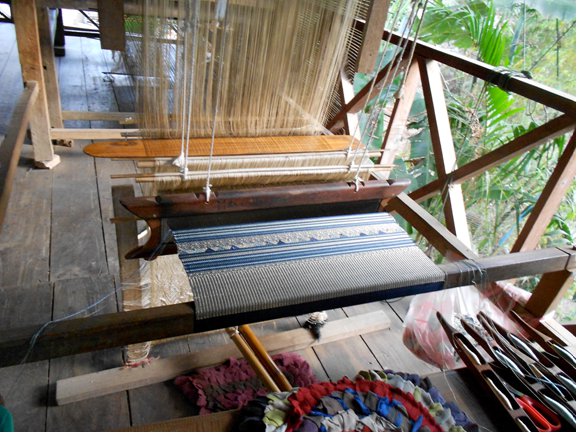
Visitors
can meet the artisans, see and learn about the silkworms
they raise, and take a number of classes and workshops.
They can also eat there, shop there, and even stay in
their four-room guest house.
Spending
several hours with Jo Smith, co-director and one of the
founders of Ock Pop Tok, I heard about the work they do,
watched several weavers at their looms, and saw the
beautiful textiles from across Laos in their shop. Seeing
the fabulous colors of yarns and materials they had dyed,
I was especially eager to learn about the their use of
natural dyes.
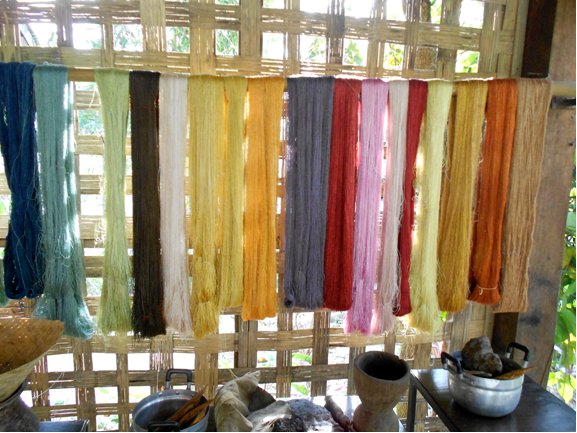
The author at the dye table with Jo Smith at Ock Pop Tok
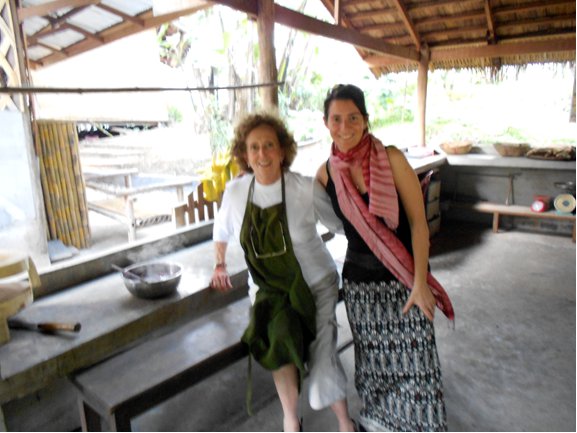
Many of
the dyes they use come from sources familiar to me, such
as turmeric, lemongrass, saffron, annatto, and, of course,
indigo.
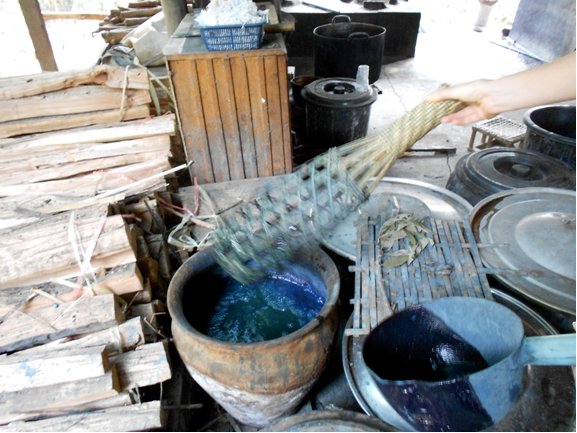
Other
dyes are derived from plants native to the region – plants
with which I was not familiar –at least not in terms of
their use as natural dyes.
One
such plant source is sappan,
(Caesalpinia sappan),
a flowering tree in the legume family native to Southeast
Asia. Fortunately, I had the opportunity to become a bit
more familiar with sappan by using it to dye a scarf. The
color it imparted to the silk was a luscious, deep
scarlet/purple.
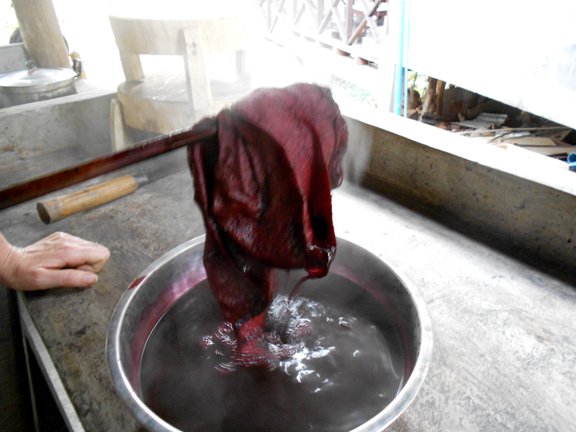
I left
Ock Pok Tok impressed with more than the aesthetic
qualities of their work, but with their goals in terms of
women’s lives as well. As a psychologist, my work involved
developing and running programs for low income women and
children, and conducting research and writing about the
lives of girls and women living in challenging
circumstances -- in the U.S. and abroad. Ock Pop Tock
educates and empowers women by advancing their artistic,
cultural and social skills, and training them in product
design, business skills and textile marketing. In this
way, they provide women essential tools for personal
growth and development.
The
next day, on our way to board the boat to visit the Pak Ou
Buddha Caves, we stopped at Ban Xieng Lek –a “weaving
village” situated on a bank high above the Mekong River.
Here on the main street and path leading down to the
river, were a number of weaving galleries and covered
outdoor studios where women worked at their looms.
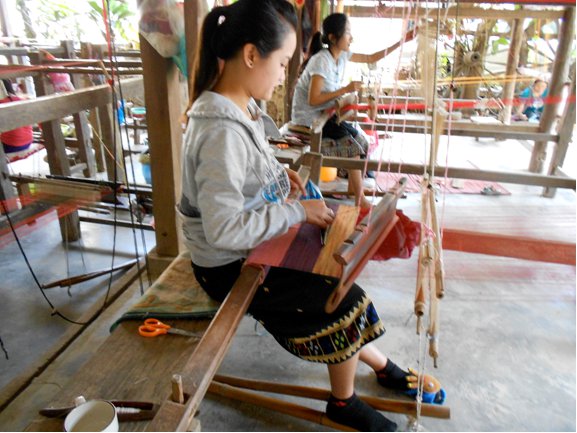
In the
studio of one of the galleries, there were shelves holding
baskets of the plants used to make natural dyes, with
skeins of naturally dyed silk hanging nearby.

Dyed silk yarn hanging to dry
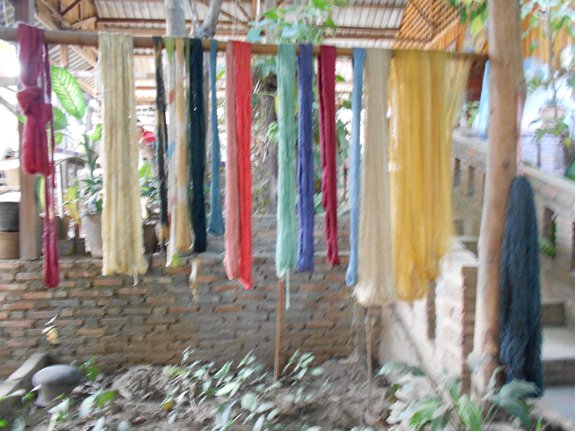
The
attached shop offered some lovely scarves and other woven
items, such as table runners of naturally dyed silk. Still
most of the products in their shop, and in all of the
shops and galleries I visited, were woven with
synthetically-dyed silk yarns. Interestingly, though, even
the synthetically dyed items were less strident than what
I have observed in other parts of the world. At least to
my eyes, the Laotian palette was a softer one in general.
In this rapidly developing country, traditional weaving is
highly valued, and traditional Lao weavers use natural
dyes. Perhaps the softer palette of the works they create
is the palette synthetic dyeing seeks to replicate. In the
weaving studios and galleries I visited, no particular
“fuss” was made of the natural dyeing process. Rather, the
influence of natural dyes subtly but strongly felt in all
that I saw.
Another
artisan center promoting natural dyes is Saoban. I did not
visit this project, but they seem like Ock Pop Tok. You
can visit their Web site, www.saobancrafts.com/our-products/silk/natural-dyeing,
to see an article on the natural dyeing they do --"Natural
Dyeing: A Demanding Art."
 Turkey Red Journal
Turkey Red Journal
